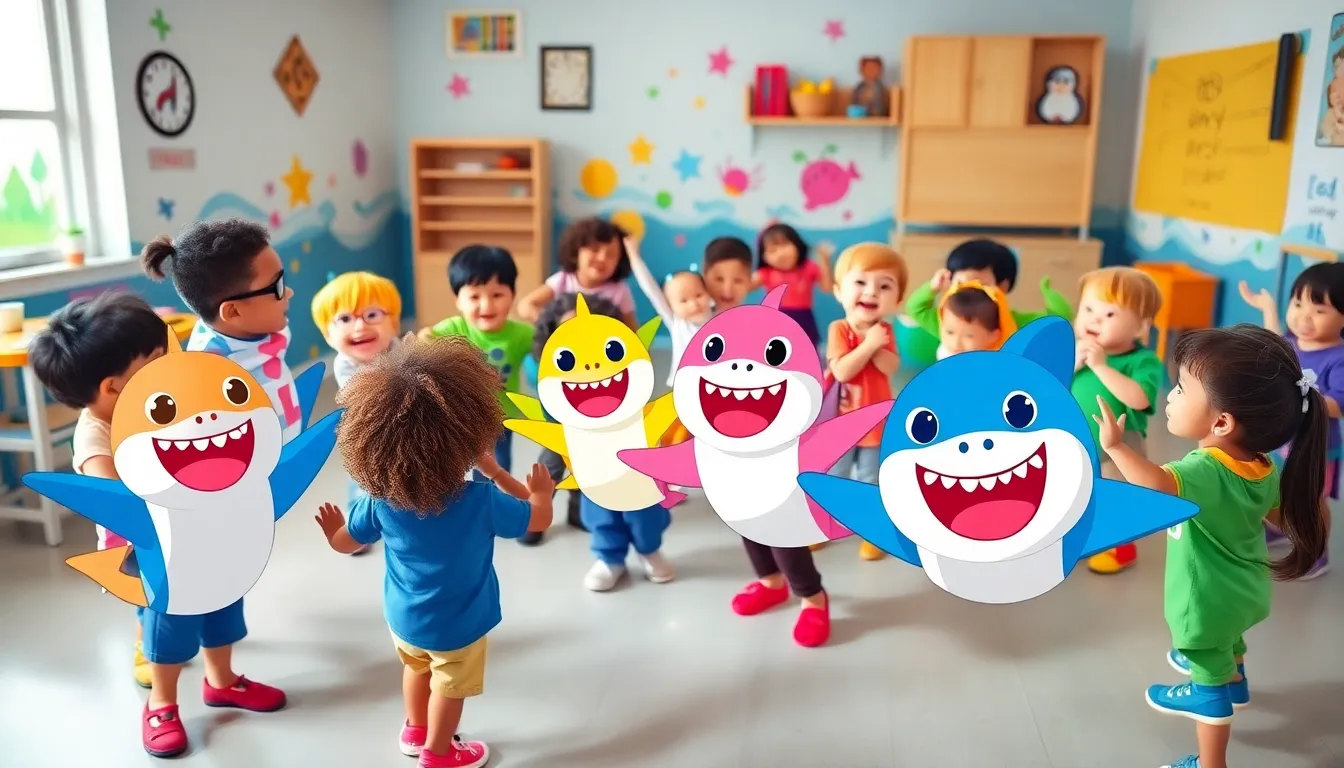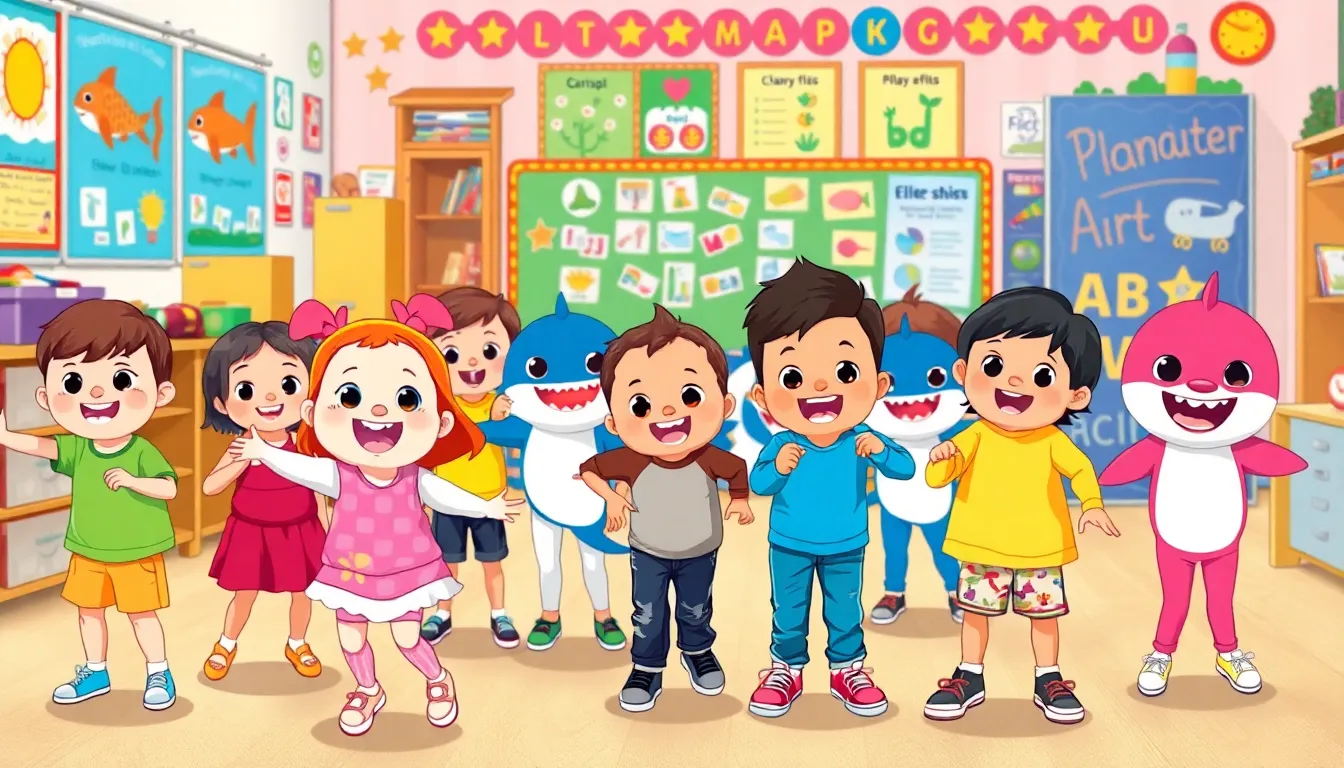Table of Contents
ToggleIn the vast ocean of children’s music, few songs have made waves quite like “Baby Shark.” But did you know that the catchy tune has its roots in a delightful 2014 version by The Kiboomers? This lively rendition takes the beloved nursery rhyme and adds a splash of fun that keeps kids dancing and parents humming along.
Overview of The Kiboomers Baby Shark – 2014 Version
The Kiboomers’ rendition of “Baby Shark” debuted in 2014 and quickly garnered widespread acclaim. This version stands out due to its catchy melody and engaging lyrics. Children easily connect with the song, often singing along enthusiastically during playtime or at home.
The upbeat tempo encourages movement, making it a popular choice for children’s activities. Kids frequently participate in dance routines inspired by the song, further enhancing their enjoyment. Parents appreciate the educational aspects integrated into the lyrics, which introduce basic concepts in a fun manner.
The Kiboomers effectively utilize simple repetition and playful language in their version. These elements are especially appealing to young audiences and contribute to the song’s enduring popularity. Its ability to create family bonding moments while encouraging active participation is commendable.
Many platforms feature this version, contributing to its viral status. View counts on YouTube demonstrate the enthusiastic reception, with millions of views in various regions. Additionally, its presence in educational settings has increased, with teachers incorporating the song into lessons.
Overall, The Kiboomers’ 2014 version of “Baby Shark” retains its charm through rhythmic simplicity and relatable themes. This approach to children’s music fosters an engaging environment where learning and fun coexist. As a result, both children and parents continue to embrace this lively tune.
History and Background

The 2014 version of “Baby Shark” by The Kiboomers significantly impacted children’s music. This catchy song quickly became a favorite among young audiences and parents.
Origins of Baby Shark
“Baby Shark” traces its roots back to traditional children’s songs. It gained popularity through various renditions, but its viral status surged with the emergence of social media. Original versions found in camps and schools often featured simple lyrics and repetitive melodies that appealed to preschoolers. These engaging qualities encouraged participatory singing and dancing. The shift from traditional to modern interpretations allowed the song to evolve while retaining its core essence.
The Kiboomers Adaptation
The Kiboomers introduced their version in 2014, enhancing the original melody with vibrant instrumentation. Their adaptation focused on creating an immersive experience for children, fostering joy and interaction. Catchy lyrics included easy-to-follow actions, inviting kids to join in on the fun. This engaging approach led to widespread popularity across platforms like YouTube. Educators also embraced it, integrating the song into classroom activities to teach basic concepts. The Kiboomers’ version showcased a perfect blend of entertainment and education, maintaining relevance in children’s programming.
Musical Composition
The musical composition of “Baby Shark” creates an engaging atmosphere for children. Rhythmic patterns and vibrant instrumentation enhance the overall experience.
Lyrics Breakdown
Lyrics in this rendition are simple and repetitive. Each line introduces a family member of the shark, allowing children to easily memorize the song. Educational concepts, such as family dynamics and marine life, are embedded within playful phrases. The structure encourages participation, making it perfect for group sing-alongs. Variations in verses, like introducing “baby,” “mommy,” and “daddy,” promote engagement and interaction.
Melody and Arrangement
Melody features a catchy, upbeat tempo that invites movement. Each note aligns with the natural rhythm that resonates with young listeners. Arrangement includes clapping and vocal harmonies, enhancing the participatory experience. The infectious beat supports children’s desire to dance and express themselves. Integration of playful sounds, such as splashes and ocean-themed elements, captures attention and stimulates imagination. Music connects with its audience, ensuring lasting enjoyment.
Visual Elements
The visual elements of The Kiboomers’ 2014 version of “Baby Shark” significantly enhance its appeal. Bright colors and engaging animations captivate young audiences, encouraging them to participate.
Animation Style
Dynamic animation styles create an inviting atmosphere. Characters move fluidly, reinforcing engagement during sing-alongs. Underwater scenes accompany the action, immersing children in a vibrant marine world. Quick transitions maintain pace, ensuring attention remains fixed on the joyful visuals. Playful gestures allow kids to mimic movements, making participation effortless. Each scene contributes to a cohesive narrative, seamlessly connecting the storyline to the cheerful melody.
Character Design
Character design features adorably stylized marine life. The shark family showcases cheerful expressions that resonate with children. Bright colors contribute to a friendly aesthetic, appealing to young viewers. Unique traits for each character help in differentiation, making learning fun. Simplified shapes enhance recognition, allowing easy identification during activities. Overall, character designs embody joy and friendliness, creating a relatable experience for kids and promoting memorable interactions.
Reception and Impact
“The Kiboomers Baby Shark – 2014 version” received significant acclaim from audiences, quickly becoming a staple in children’s music. Its catchy melody and engaging lyrics resonated with both children and parents alike. Parents praised the song for its educational content, which introduces basic concepts while fostering family interaction. Kids enthusiastically participated in dance routines, enhancing the song’s popularity.
Audience Reactions
Positive reactions poured in from various demographics. Children enjoyed the infectious melody, often requesting to sing it repeatedly. Feedback from parents highlighted its fun approach to teaching, reinforcing concepts about family and marine life. The song’s presence on platforms like YouTube showed an overwhelming number of views, demonstrating its widespread appeal. Social media played a key role, as families shared videos of their kids dancing, further amplifying its reach and impact.
Influence on Children’s Music
Impact on children’s music has been notable since the song’s release. The repetitive structure and easy-to-remember lyrics set a new trend in educational children’s tunes. This approach made the song an example for other artists, showcasing how to engage young audiences effectively. Many educators began integrating similar catchy songs, understanding their potential for enhancing learning experiences. The song’s viral success influenced a wide array of merchandise, further embedding it in popular culture and children’s programming.
The Kiboomers’ 2014 version of “Baby Shark” has undeniably left a lasting impact on children’s music. Its catchy melody and engaging visuals create an immersive experience that resonates with young audiences. The song not only entertains but also educates, making it a valuable tool for parents and educators alike.
As it continues to inspire dance routines and joyful sing-alongs, “Baby Shark” remains a staple in children’s programming. Its viral success showcases the power of music to foster family bonding and learning. The legacy of this vibrant rendition is sure to endure, captivating generations to come.




